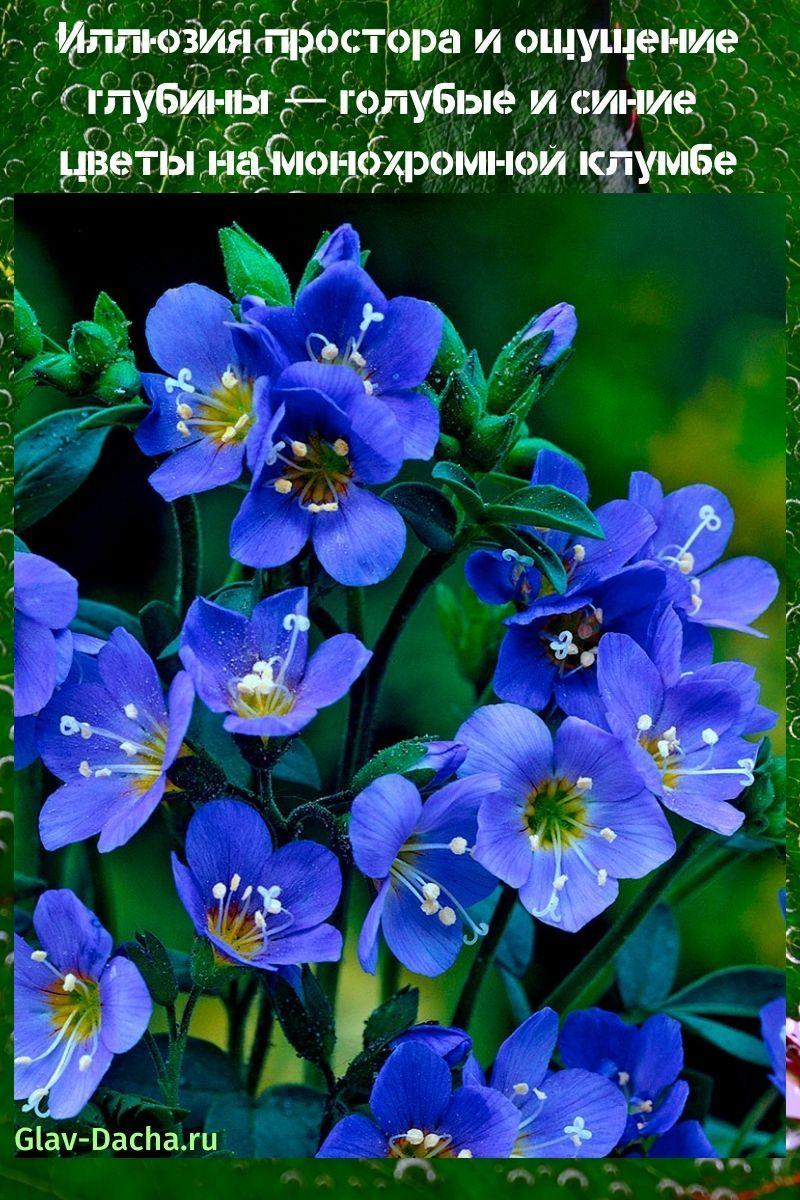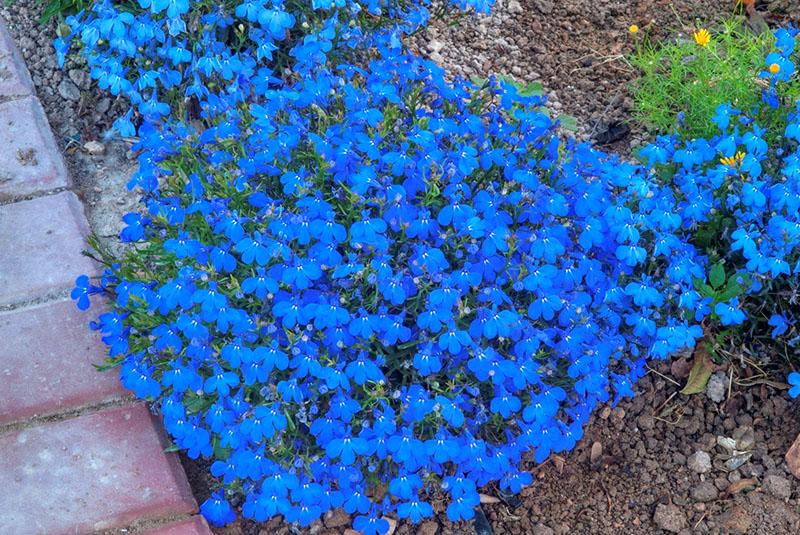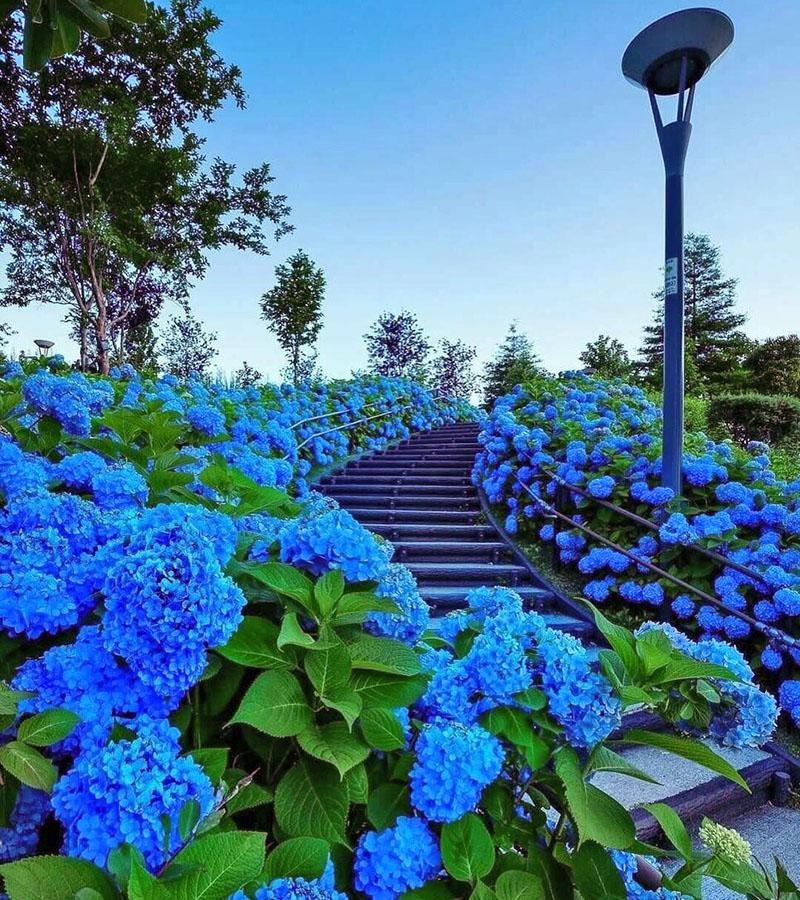The illusion of spaciousness and a sense of depth - blue and blue flowers in a monochrome flower bed
 For more than one millennium, vibrant cultures have been raising people's spirits and giving them joy. Particularly impressive are the blue and blue flowers planted in the same flower bed. When choosing species and varieties, gardeners take into account the height of the plants, the size and configuration of the buds. The flowering period and life span play an important role.
For more than one millennium, vibrant cultures have been raising people's spirits and giving them joy. Particularly impressive are the blue and blue flowers planted in the same flower bed. When choosing species and varieties, gardeners take into account the height of the plants, the size and configuration of the buds. The flowering period and life span play an important role. 
Guidelines for plant selection

All flowers that are grown in open areas are divided into 3 groups:
- annual;
- biennial;
- perennial.
The first includes cultures that are capable of completely passing all stages of life in one season. They develop successfully, decorate themselves with inflorescences, pollinate and bear fruit. And in the fall, they bring seeds and disappear forever. Despite this, annuals are very popular with designers. The richness of varieties allows you to create unique compositions every year.
Once flowering, annual crops can be removed and a new flower bed arranged.
In biennial plants, buds appear only in the next season. Some specimens live longer than the prescribed period, which is very pleasing to gardeners. However, perennials are considered the most valuable "company". They retain their original decorativeness for decades. In most perennials, leaves and branches die off. The underground part resumes vegetation as soon as suitable conditions are created. To choose suitable flowers for a flower bed, you need to get acquainted with them. Let's open and leaf through the "book" of bright plants for the garden.
Blue and blue flowers at our feet
 The famous phrase "Everything in good time" applies not only to people, but also to plants. Each of them develops in a precisely designated period. And sky-blue flowers adorn our life with love. Even if only one season. Let's get acquainted with the most popular copies.
The famous phrase "Everything in good time" applies not only to people, but also to plants. Each of them develops in a precisely designated period. And sky-blue flowers adorn our life with love. Even if only one season. Let's get acquainted with the most popular copies.
knapweed
 The unpretentious plant attracts the attention of fans of wildflowers. It is often found among wheat crops. Cultivated cornflowers wonderfully fit into the countryside landscape when grown in flower beds in company with other flowers. Erect shoots of the plant are strewn with narrow leaves of a deep green color. When the time comes, the bush puts on a "veil" of many graceful buds, painted in different shades of blue.
The unpretentious plant attracts the attention of fans of wildflowers. It is often found among wheat crops. Cultivated cornflowers wonderfully fit into the countryside landscape when grown in flower beds in company with other flowers. Erect shoots of the plant are strewn with narrow leaves of a deep green color. When the time comes, the bush puts on a "veil" of many graceful buds, painted in different shades of blue.
Most often, varieties are grown on flower beds:
- meadow;
- mountain;
- blue.
Other types of cornflowers are colored lilac, pink and white. However, in a monochrome flower bed, blue annual garden flowers look very stylish. The flowering culture begins in the summer and lasts until the first frost. The buds are graceful baskets consisting of delicate petals with a carved frame.
In an ordinary flower bed, cornflowers are harmoniously combined with white daisies, scarlet poppies. In monochrome plantings, they are often grown with bells.
Petunia
 It is impossible to pass by the flower beds with charming flowers that exude a pleasant aroma. Petunias grow in small bushes formed by branched shoots. In the root area there is a dark green oval foliage. Every summer, the plant is adorned with delicate buds of almost all colors of the rainbow.
It is impossible to pass by the flower beds with charming flowers that exude a pleasant aroma. Petunias grow in small bushes formed by branched shoots. In the root area there is a dark green oval foliage. Every summer, the plant is adorned with delicate buds of almost all colors of the rainbow.
However, for a monochrome blue flower bed, only these varieties are suitable:
- Blue waterfall;
- "Peppy blue";
- Blue ivy;
- Merlin Morne;
- Blue Wave.
 Each of them has its own unique beauty. All exude a pleasant aroma that turns the countryside into a garden of delight. Petunia blooms all summer, including September, if autumn is warm.
Each of them has its own unique beauty. All exude a pleasant aroma that turns the countryside into a garden of delight. Petunia blooms all summer, including September, if autumn is warm.
Petunia is sown for seedlings in late February or early March. They are transferred to the flowerbed in May.
Asters
 At the end of August, summer cottages are decorated with magnificent blue garden flowers with an exquisite aroma. Asters rightfully occupy a special position among their relatives. They are unpretentious in care, are not afraid of frosts and endure dry periods. Annual or perennial options look spectacular in the gardens of our compatriots.
At the end of August, summer cottages are decorated with magnificent blue garden flowers with an exquisite aroma. Asters rightfully occupy a special position among their relatives. They are unpretentious in care, are not afraid of frosts and endure dry periods. Annual or perennial options look spectacular in the gardens of our compatriots.
Varieties with blue and blue color of buds especially attract attention. The most popular are:
- Alpine blue;

- Lady in Blue;

- Blue Lagoon;

- Little Boy Blue;

- Royal Blue.

The culture has a strong erect stem that grows from 20 to 85 cm in height. The root system is the same for all species, but the buds are different. Some resemble chamomiles, while others look like chrysanthemums. There is a solution for every gardener.
Many people call asters autumn flowers. In fact, the first buds bloom in June.
Elegant monochrome mixborder
 Once planted in a summer cottage, a flower bed has been pleasing the hearts of its fans for decades. It only requires regular watering, weeding and fertilization. To create such a miracle, you need perennial blue flowers with graceful bud shapes. Continuing to leaf through the "Book of Creations", we will select suitable copies.
Once planted in a summer cottage, a flower bed has been pleasing the hearts of its fans for decades. It only requires regular watering, weeding and fertilization. To create such a miracle, you need perennial blue flowers with graceful bud shapes. Continuing to leaf through the "Book of Creations", we will select suitable copies.
Delphinium
 A tall perennial plant rises 2 m to the sky. Its slender stems are adorned with graceful pyramidal buds. On average, the diameter of each of them reaches 7 cm. Inflorescences are both simple and double. There are spurs on the back of the bud. Popular view delphinium Belladonna is considered with blue and blue flowers.
A tall perennial plant rises 2 m to the sky. Its slender stems are adorned with graceful pyramidal buds. On average, the diameter of each of them reaches 7 cm. Inflorescences are both simple and double. There are spurs on the back of the bud. Popular view delphinium Belladonna is considered with blue and blue flowers.
Taking it as a basis, breeders bred a number of varieties with buds painted in heavenly tones:
- Arnold Becklin;
- Casa Blanca;
- Lamartine;
- Piccolo;
- Kleine.
In addition, there are other types of blue and blue delphiniums. The Chinese large flowers and the Foster group have gained particular popularity. The culture takes root wonderfully in the middle latitudes. Handles harsh winters under reliable additional cover.
In order to preserve the pristine beauty of the buds, it is advisable to propagate hybrid varieties of delphiniums by dividing the bush.
Meconopsis
 The plant is also known as the Tibetan or Himalayan poppy. Its delicate petals are painted in sky blue. In nature, it is found on mountain slopes. However, it wonderfully takes root in summer cottages.
The plant is also known as the Tibetan or Himalayan poppy. Its delicate petals are painted in sky blue. In nature, it is found on mountain slopes. However, it wonderfully takes root in summer cottages.
From the side, meconopsis really resembles a poppy. It has an erect stem with gray-green leafy plates of various shapes. They can be whole or split. In addition, the leaves are collected in graceful rosettes. The flower is crowned with large single buds, the diameter of which often reaches 20 cm. Flowering occurs in summer and lasts about 4 weeks.
To date, breeders have bred a number of varieties with white, yellow and scarlet buds.
Platicodon
 The flower grows to a maximum of 80 cm. It has erect shoots on which serrated oval leaves are located. During the flowering period, bells form on the tops. They are collected in paniculate inflorescences of several pieces.
The flower grows to a maximum of 80 cm. It has erect shoots on which serrated oval leaves are located. During the flowering period, bells form on the tops. They are collected in paniculate inflorescences of several pieces.
The culture is also known as the large-flowered shirokokolokolchik. It is propagated using seeds that are sown before winter. Platycodon blooms only 3 years later.
Iridodictum
 A cute dark blue flower can decorate any flower bed. Its petals, pleasant to the touch, look like an iris.However, it blooms in mid-April, along with the traditional primroses.
A cute dark blue flower can decorate any flower bed. Its petals, pleasant to the touch, look like an iris.However, it blooms in mid-April, along with the traditional primroses.
To date, such popular types are known:
- Kantab;
- Harmony;
- Natasha;
- Joyce;
- Royal Beauty.
The leaf plates of the iridodictum resemble three- or four-sided swords with pointed tips. In spring, their length reaches 20 cm, and after flowering, it increases by 4 times. Therefore, they decorate the flower bed for almost the entire season.
Pushkinia proleskovidnaya
 Most often, the plant is grown in rock gardens, since its homeland is the Caucasus. There it grows on mountain slopes with rocky soil. Outwardly, the forest-like Pushkinia resembles a hyacinth. However, it is decorated with bell-shaped little blue flowers, collected in a brush, about 12 cm long.
Most often, the plant is grown in rock gardens, since its homeland is the Caucasus. There it grows on mountain slopes with rocky soil. Outwardly, the forest-like Pushkinia resembles a hyacinth. However, it is decorated with bell-shaped little blue flowers, collected in a brush, about 12 cm long.
They dissolve in the last days of March or early April. Flowering lasts about 25 days. Then the fruit appears in the form of a round fleshy box. Small brown seeds are stored inside. By the beginning of summer, the leaf plates and buds dry up and the Pushkinia "plunges" into a state of rest.
Lebanese Pushkinia with light blue buds can be grown on a monochrome flower bed.
Blue and blue clematis flowers
 The plant is a perennial decorative flowering liana. Botanists count up to 150 types of culture, which have significant differences. Some clematis shed their leaves at the end of the growing season, others keep them until spring. In addition, depending on the variety, the shape, color of the buds and the flowering period change. The length of the graceful liana sometimes exceeds 3 m, and the shrub forms reach only 1.5 m.
The plant is a perennial decorative flowering liana. Botanists count up to 150 types of culture, which have significant differences. Some clematis shed their leaves at the end of the growing season, others keep them until spring. In addition, depending on the variety, the shape, color of the buds and the flowering period change. The length of the graceful liana sometimes exceeds 3 m, and the shrub forms reach only 1.5 m.
Popular varieties of blue and blue clematis:
- Turquoise;

- Ramona;

- Claudia Shulzhenko;

- Lawsonian.

Among the many wonderful options, Alpine clematis also stands out for its special beauty. Against the background of dense dark green foliage, small blue flowers look very impressive. A lush liana is planted near the porch of a residential building, next to a gazebo or at the entrance gate. The refreshing color of the buds resembles the vastness of the sea, and the heady aroma pleases the heart.
Ground cover perennial veronica
 Blooming ground cover perennials are an indispensable element of a modern garden. They transform the most unsightly area into a chic retreat. A huge number of miniature bushes creep along the ground like an avalanche that descends from the mountains and sweeps away everything in its path.
Blooming ground cover perennials are an indispensable element of a modern garden. They transform the most unsightly area into a chic retreat. A huge number of miniature bushes creep along the ground like an avalanche that descends from the mountains and sweeps away everything in its path.
 Veronica is a shrub with a height of 10 to 40 cm. Thin stems are covered with oval leaves with a toothed frame. During the period of mass flowering, loose inflorescences are formed on the culture, consisting of large buds of blue or sky blue. The plant is actively used to decorate the garden area.
Veronica is a shrub with a height of 10 to 40 cm. Thin stems are covered with oval leaves with a toothed frame. During the period of mass flowering, loose inflorescences are formed on the culture, consisting of large buds of blue or sky blue. The plant is actively used to decorate the garden area.
Having got acquainted with the popular blue and blue flowers, we will hasten to equip a monochrome flower bed on our site. Annual and perennial crops are suitable for business. Each of them has many varieties that can become a true highlight of the garden.